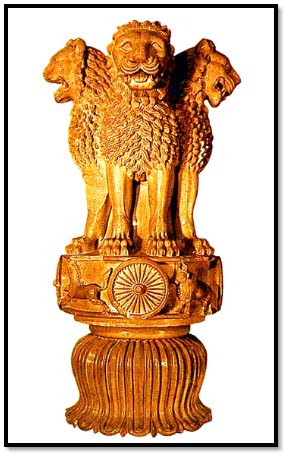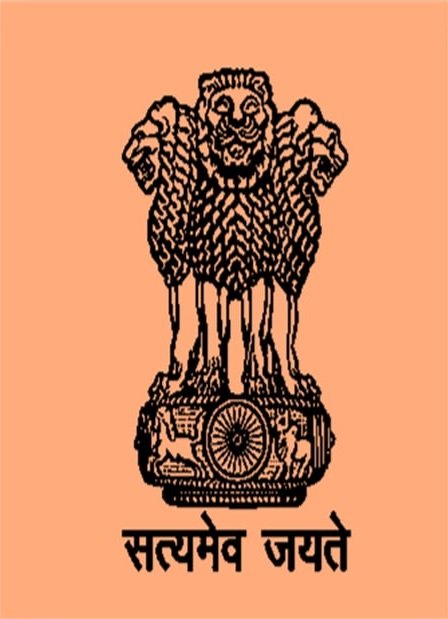Table of Contents
National Emblem of India
An emblem by definition is “a heraldic object or symbolic object as a unique insignia that represents any country or organization, or something that represents a particular person, group, idea, quality”. The emblem word comes from the Greek word “emblema“, which means “embossed ornament“. An emblem may be worn or otherwise used as an identifying badge or patch.
The national emblem of India is an adaptation of the Lion Capital atop the Ashoka Pillar of Sarnath, Uttar Pradesh, and is combined with the words “Satyameva Jayate”, written in Devnagari Script. The words “Satyameva Jayate” are the National Motto of India. It is translated as ‘Truth alone triumphs’. The words “Satyameva Jayate” are a quote from Mundaka Upanishad, which is an ancient Sanskrit Vedic text, embedded inside Atharva Veda. The National Emblem of India is also called the State Emblem of India. Some basic knowledge about the National Emblem of India is given in the table given below.
| Representative of | Republic of India |
| Based on | The Lion Capital of the Ashoka Pillar in Sarnath, Uttar Pradesh |
| Motto | Satyameva Jayate / Truth Alone Triumphs |
| Adopted by | Madhav Sawhney |
| Adopted on | 26 January, 1950 |
 The Lion Capital crowning the Ashok Pillar at Sarnath is carved out of a single block of yellow sand stone and features four Asiatic Lions sitting back-to-back on the short cylindrical circular base, as a symbol of power, courage, confidence, and pride. On the circumference of this short cylindrical base, there are four Chakras corresponding to each lion bust and reliefs of four more animals in between them – the lion, the bull, the elephant and the galloping horse. These four animals depicted alternatively between the chakras are regarded as the guardians of four directions – the lion for the north, the elephant for the east, the horse for the south and the bull for the west. These animals are proceeding in a clockwise direction. The Chakra is a form of Buddhist Dharma Chakra and is known as the Ashok Chakra after the emperor who popularized it. The 24 spokes of the Chakra represent the number of hours in a day, and portray the passage of time. This short cylindrical base is over a bell-shaped lotus.
The Lion Capital crowning the Ashok Pillar at Sarnath is carved out of a single block of yellow sand stone and features four Asiatic Lions sitting back-to-back on the short cylindrical circular base, as a symbol of power, courage, confidence, and pride. On the circumference of this short cylindrical base, there are four Chakras corresponding to each lion bust and reliefs of four more animals in between them – the lion, the bull, the elephant and the galloping horse. These four animals depicted alternatively between the chakras are regarded as the guardians of four directions – the lion for the north, the elephant for the east, the horse for the south and the bull for the west. These animals are proceeding in a clockwise direction. The Chakra is a form of Buddhist Dharma Chakra and is known as the Ashok Chakra after the emperor who popularized it. The 24 spokes of the Chakra represent the number of hours in a day, and portray the passage of time. This short cylindrical base is over a bell-shaped lotus.
 The National Emblem is a graphic representation of the Lion Capital that originally graced the top of the Ashoka Pillar at Sarnath, along with the National Motto written below it. Due to the two-dimensional representation of the National Emblem, only three lions show, and the fourth lion is hidden from view. Due to the two-dimensional form of the National Emblem, only one Ashok Chakra is visible on the circumference of the cylindrical base, with a bull on the right side of this Chakra and a galloping horse on the left side of this Chakra, and the right and left side on the circumference of the cylindrical base show outlines of Ashok Chakras. The three lions represent in the National Emblem signify Strength, Courage and Confidence.
The National Emblem is a graphic representation of the Lion Capital that originally graced the top of the Ashoka Pillar at Sarnath, along with the National Motto written below it. Due to the two-dimensional representation of the National Emblem, only three lions show, and the fourth lion is hidden from view. Due to the two-dimensional form of the National Emblem, only one Ashok Chakra is visible on the circumference of the cylindrical base, with a bull on the right side of this Chakra and a galloping horse on the left side of this Chakra, and the right and left side on the circumference of the cylindrical base show outlines of Ashok Chakras. The three lions represent in the National Emblem signify Strength, Courage and Confidence.
The bull represents hard work and steadfastness, while the horse represents loyalty, speed, and energy. The bell-shaped lotus beneath the cylindrical base has been omitted in the national emblem. The National Emblem of India was officially adopted by Madhav Sawhney on the day India became a republic, on 26th January 1950.
Use of National Emblem
The National Emblem is used for official purposes only. It acts as the official seal for all national and state government offices and is the compulsory part of any letterhead used by the government. It is a part of all Indian currency and the National Passport of the Republic of India. Indian Police Service Officers (IPS) wear the state emblem on their caps, and Members of Parliament (MPs) can also use the state emblem on their letterheads and visiting cards. It is the symbol of sovereignty for India.
The National Emblem can be displayed in public buildings such as Rashtrapati Bhawan, Parliament House, Supreme Court, Central Secretariat buildings, Raj Bhawan, State Legislature, High Courts, Secretariat buildings of the States or the Union territories, the premises of India’s Diplomatic Mission abroad and at the entrance doors of buildings occupied by India’s Consulates abroad.
However, the National Emblem of India can only be used as per provisions of the State Emblem of India (Prohibition of Improper Use) Act-2005, and any unauthorized use is punishable under law. There is a punishment of imprisonment of up to two years or a fine of up to INR 5000 if someone violates the law concerning the usage of the National Emblem.
Some important fact
- The Lion Capital was erected by Mauryan Emperor Ashoka during the year 250 BC to mark the spot where Buddha imparted his knowledge of Dharma to his five disciples.
- Many such other pillars were erected by the emperor Ashoka, but most of them contain a single animal on top.
- The Sarnath Ashoka pillar had originally sunk into the ground and wasn’t visible.
- German-born civil engineer Friedrich Oscar Oerte started the excavation in Sarnath in December 1904 and ended in April 1905. He unearths the Ashoka pillar in March 1905, and the whole pillar was found in three sections. The topmost Lion Capital was found intact and is currently displayed in the Sarnath Museum.
- Dinanath Bhargava sketched and illuminated India’s national emblem. He was assigned the work to design the emblem for the first page of the Indian Constitution.
- The Lion Capital of Sarnath Ashoka pillar became the emblem of the Dominion of India in December 1947, and later the emblem of the Republic of India.
